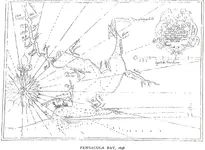pcolaboy
Hero Member
- Joined
- Sep 5, 2006
- Messages
- 916
- Reaction score
- 14
- Golden Thread
- 0
- Location
- Pensacola, Fl
- Detector(s) used
- Minelab Explorer XS
GuyInBlack has a pretty good point and certainly take responsibility for running us off on a tangent. I think I will start a different thread to further discuss any Pensacola Bay wrecks.
Even though my family has been in Pensacola for generations, there is still very little substantiated history of lower Perdido Bay and Perdido Pass - at least data which is available on the internet. I am going to extend my search of information by going to University of West Florida's library that has a pretty extensive special collections department containing very very old documents, maps, pictures, etc. It's kind of funny because you have to sign a piece of paper saying that you'll not attempt to locate any historic sites or resources from the information you obtain.
Here's what I'll be focussing on from the 1550's to present day:
1. Historical geography of Perdido Pass and navigable waterways to Perdido Bay and River
2. Land ownership plats and land use information
3. Colonial-era settlements (I know there was one on the Alabama Side of Perdido Bay where a large development of homes were built and there is even an old Spanish cemetary there)
4. Verify the location of the old Spanish ferry that ran across the middle of Perdido Bay. I believe this is where part of Galvez's forces crossed to encircle the British and Creek Indian forces during the Siege of Pensacola in 1781.
5. Try to narrow down the location of the first Mobile-Pensacola road that utilized the ferry system. The British established another Mobile-Pensacola road much further north that crossed the river instead of the bay when they took over the West Florida territory 1763. It is widely believed that this route closely follows Hwy 90 for a majority of the path and was later erroneously included in the "Old Spanish Trail" paved road project during the 1920's.
6. Obtain the latest soundings of Perdido Bay performed by the NOAA and compare with any old maps I find with soundings and develop a likely area for shipwrecks. This shouldn't be too hard to do since a majority of the bay would not be passable by anything greater than a 7 foot draft.
Any other suggestions for data acquisition are welcomed!
Pcolaboy
Even though my family has been in Pensacola for generations, there is still very little substantiated history of lower Perdido Bay and Perdido Pass - at least data which is available on the internet. I am going to extend my search of information by going to University of West Florida's library that has a pretty extensive special collections department containing very very old documents, maps, pictures, etc. It's kind of funny because you have to sign a piece of paper saying that you'll not attempt to locate any historic sites or resources from the information you obtain.
Here's what I'll be focussing on from the 1550's to present day:
1. Historical geography of Perdido Pass and navigable waterways to Perdido Bay and River
2. Land ownership plats and land use information
3. Colonial-era settlements (I know there was one on the Alabama Side of Perdido Bay where a large development of homes were built and there is even an old Spanish cemetary there)
4. Verify the location of the old Spanish ferry that ran across the middle of Perdido Bay. I believe this is where part of Galvez's forces crossed to encircle the British and Creek Indian forces during the Siege of Pensacola in 1781.
5. Try to narrow down the location of the first Mobile-Pensacola road that utilized the ferry system. The British established another Mobile-Pensacola road much further north that crossed the river instead of the bay when they took over the West Florida territory 1763. It is widely believed that this route closely follows Hwy 90 for a majority of the path and was later erroneously included in the "Old Spanish Trail" paved road project during the 1920's.
6. Obtain the latest soundings of Perdido Bay performed by the NOAA and compare with any old maps I find with soundings and develop a likely area for shipwrecks. This shouldn't be too hard to do since a majority of the bay would not be passable by anything greater than a 7 foot draft.
Any other suggestions for data acquisition are welcomed!
Pcolaboy



 ... a zillion more leads!!!
... a zillion more leads!!!


